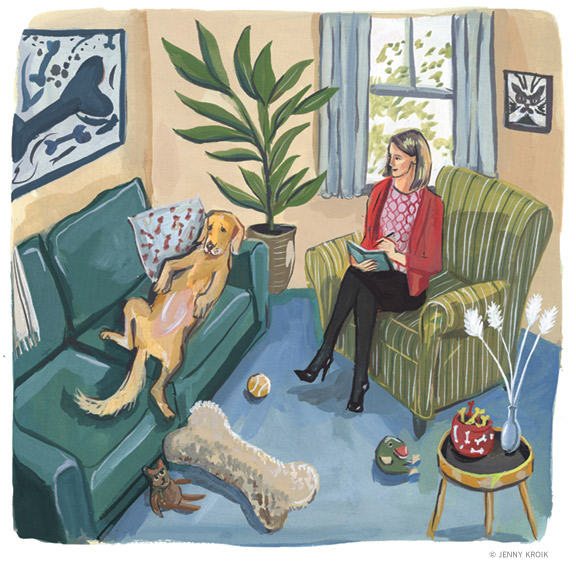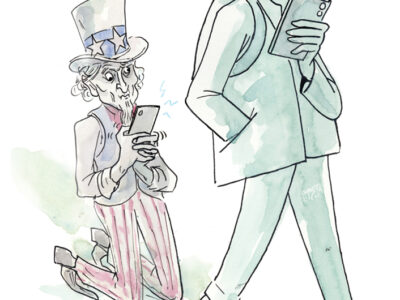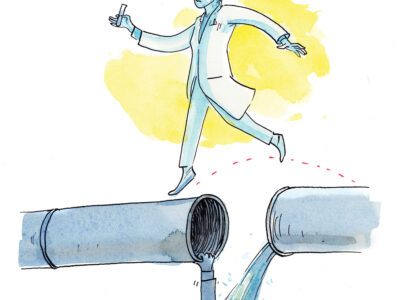
The pandemic upended the lives of some pets. The return of “normality” could be even more stressful. But help may be a click away.
By Kathryn Levy Feldman
About eight months into the pandemic, I received a plea from my high school class’s secretary for material she could use in the class notes section of our alumni newsletter. What, she wanted to know, had people learned from the pandemic thus far?
I did not have to think twice. “My dogs truly are therapy dogs,” I wrote back. My golden retrievers, Millie and Franklin, are certified, together with me as their handler, as therapy dog teams by the Alliance of Therapy Dogs [“Power of the Pup,” Jul|Aug 2020]. Before the pandemic, I had only been on the giving end of this service. My dogs and I worked with children with learning differences as well as at the Children’s Hospital of Philadelphia. But when our official therapy work shut down, my husband and I became the default beneficiaries of their therapeutic skills.
Franklin camped out most days in my husband’s home CPA office and kept him company while he navigated the never-ending tax season. Franklin learned to ignore the shrill speakerphone and the pings from constant emails. He sidled up to my husband throughout the day for extra scratches and pats, but for the most part was content to snooze until it was time to go for a walk, eat, or, best of all, play ball. He monitored the comings and goings of the UPS truck and Instacart deliveries from the window and seemed pleased that no one was leaving the house very much. My husband was equally delighted to have an office assistant and I often caught him taking a break by giving Franklin extra belly rubs.
Millie was my constant companion. She followed me wherever I went in the house—which is pretty normal for her. My behavior was a little less normal: I found myself talking to her all the time. She knew how I planned to spend the day and what we were going to have for dinner. We did a lot of ball retrieving in the backyard. For the most part, I tried to uphold the dogs’ regular routine of daily walks to the park and around the neighborhood. It did as much for me as it did for them. I was able to see my dog park friends, from a safe distance, grateful that Franklin and Millie continued to provide me with those connections.
One thing was different: for an entire year, I don’t think that we ever left the dogs alone in the house.
I thought the dogs had weathered the pandemic pretty well. Apart from putting on a few pounds from lounging about and chowing down on extra snacks, they seemed none the worse for wear. So when I got a call that therapy visits were starting up again—outdoors, with very small numbers of children—I signed up with Franklin, who has the most natural affinity for kids.
Our session with five children and three dogs began with a brief introduction in a classroom before a planned walk. Everything was going beautifully. Franklin flawlessly laid down on command and was focused on me (and the treat bag) when out of the corner of his eye he spied another therapy dog in the corner of the room. All of a sudden, my certified therapy dog was barking and lunging at that dog. I quickly removed Franklin from the room and retreated to a far corner of the property. Out of range, he morphed back into my perfect pet and the kids were able to walk him without incident—as long as we kept our distance from the other dogs.
Shocked and somewhat mortified by Franklin’s outburst, I called a trainer. It turns out that I was hardly the only pet owner noticing a dog’s bumpy transition back to pre-pandemic life. Dr. KimMi Whitehead V’10, a criticalist at the Veterinary Specialty Center of Delaware and CEO of Intellivets, a veterinary telehealth company, suggested that despite my good intentions, my dogs had spent the last year picking up on a lot of “nonverbal cues” that I hadn’t thought about. When I did start to think about it, some of the problems became quite clear. I had spent months wearing a mask and moving to the other side of the street whenever another person or dog approached. No wonder Franklin had grown wary of strangers and other dogs. And that wasn’t the only thing. Remember the early pandemic days when everyone was wiping down groceries? Well, I was wiping down my dogs with alcohol towelettes every time they encountered another dog or person. And while it would take a lot for Franklin to be afraid of kids, he clearly was picking up on my anxiety each time we had contact with someone outside of our house.
In Franklin’s case, I had also gotten lazy at making him work for a reward. A training session reminded me to go back to basics and make Franklin earn his treats. I’m happy to report that Franklin has completed four more therapy sessions with no more incidents. He is again a lovable creature who basks in the attention of adoring fans. One student even asked him to sign her yearbook—which he did, of course, with a big pawprint.
Although my story has a happy ending, not all pets are figuring out post-pandemic life. According to Carlo Siracusa, associate professor of clinical animal behavior and welfare and director of Penn Vet’s small animal behavior service, pets have faced a twofold challenge. First, they had to adapt to our pandemic schedules, which were often very different from their previous routines. And now, having made that adjustment, they are faced with another set of adjustments as the pandemic’s grip loosens. These changes have intensified pets’ feelings of powerlessness to control their environments. “They have to take whatever we decide,” Siracusa explains. “If we want to take a walk when we want to take a walk, then they will follow. The exception, of course, is dogs that have access to backyards where they can go and spend some time away from us.”
The rules governing the next phase of life are unpredictable. “It is not necessarily going back to what it used to be,” Siracusa notes. However quickly or slowly particular dogs are able to adapt, “there is going to be some level of challenge that our dogs are going to experience.” When those challenges fall on new owners of “pandemic puppies,” the consequences can be heavy.
“Behavior problems are a leading cause of surrendering animals to a shelter,” says Siracusa, noting that separation anxiety is a classic trigger for dogs acting out. Dogs whose underlying behavior problems were eased by constant companionship during the pandemic are liable to relapse if their owners abruptly leave and spend eight hours a day at the office.
Will newly busy families have the bandwidth to deal with that challenge, or are animal shelters about to be overwhelmed by surrendered dogs?
“I think the human-animal bond is very strong,” Siracusa says. “So I do expect most people to be able to work on the problem—but there will be a percentage that will not have any other choice but to surrender the pet back to the shelter.” One thing is certain, he says. “If we take the time to make a gradual adjustment, then it’s going to be much easier on our pets.”
For people who are struggling with behavior changes in their pets, Penn Vet has a new telehealth behavior platform, Penn Vet Behavior App, that can be accessed through your veterinarian. Developed by Intellivets in conjunction with Connect for Education and Penn Vet’s Center for the Interaction of Animals and Society, the app creates a three-way conversation between the pet owner, the referring vet, and a behavioral specialist. The consultation encompasses a questionnaire, the pet’s medical record (which often can provide insight into behavioral issues), and the ability to upload videos of troubling behavior. By examining the dog’s body language in addition to other information, the behavioral team can offer suggestions for the owner. The app also houses a resource library curated by Penn Vet for the benefit of both owners and veterinarians, which is accessible to all users—even if they don’t use the consultation function.
Since the pandemic began, Siracusa says this service has seen an increase in requests for consultations. “Is this coming change going to be another major one?” he asks. “I think it depends on how gradual the change is going to be for the caregivers, the owners.
“Our pets are doing their best to understand what is happening in our lives,” he adds. “Their behavior is not related to being very spiteful or misbehaving. They are trying to recalculate their route.”
Kathryn Levy Feldman LPS’09 last wrote for the Gazette about therapy dogs in the Penn Hospital system.





excellent article!!!!